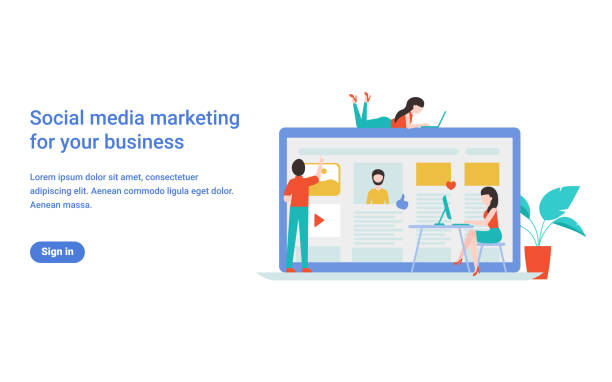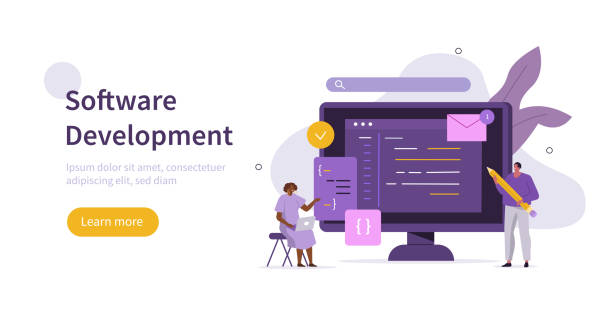Why Secure Website Design Is Crucial: An Introduction to Web Security

In today’s digital world, maintaining website security is not just an advantage, but an undeniable necessity.
With the increasing proliferation of cyber threats, every business, regardless of size and type of activity, must consider secure website design and strengthening its defensive infrastructure.
#Website_Security is no longer a vague term, but a core pillar for preserving reputation, sensitive data, and user trust.
An insecure website can lead to loss of customer information, Denial of Service (DDoS) attacks, brand reputation damage, and even financial crimes.
This section helps you gain a deeper understanding of the vital importance of web security and its role in your long-term online success.
The principles of #Website_Security go beyond installing a simple antivirus and include a set of preventive measures, secure coding, proper server configuration, and continuous maintenance.
Ignoring these aspects can have irreparable consequences for any organization.
Are your e-commerce site ready to attract maximum customers and increase sales? Rasaweb transforms your online business with modern and efficient e-commerce website design.
✅ Increase speed and improve SEO
✅ Excellent user experience on mobile and desktop⚡ Get free e-commerce website design consultation from Rasaweb now!
Identifying Common Website Threats and Countermeasures

To begin a secure website design, the first step is to know the enemy: common website threats.
Cyberattacks come in various forms, each requiring a different approach to counter.
Among the most common and destructive of these attacks is SQL Injection, which allows attackers to exploit weaknesses in form inputs to penetrate the database and steal or manipulate sensitive information.
XSS (Cross-Site Scripting) attacks are also dangerous, as an attacker can inject malicious code into the website to steal user information or take control of their browser.
DDoS (Distributed Denial of Service) attacks make the website inaccessible to real users by sending a massive volume of traffic to the server.
In addition, phishing, Brute-Force attacks to crack passwords, and malware injection are also constant threats.
A thorough understanding of these vulnerabilities and the implementation of appropriate defensive solutions, including input filtering, using Web Application Firewalls (WAFs), and implementing strong authentication, are among the most fundamental steps in any secure website design.
This section specifically examines these threats and their prevention and countermeasures.
Secure Coding Principles and Best Practices for Developers

One of the main pillars of secure website design is implementing secure coding principles from the very early stages of development.
This proactive approach can prevent many vulnerabilities.
For example, thorough Input Validation is vital to prevent attacks like SQL Injection and XSS; any data received from the user must be reviewed and sanitized before processing.
Proper Session Management is also very important; session tokens must be random, unpredictable, and have a limited lifespan to prevent session hijacking.
Secure Error Handling and Logging are also essential; error messages should not reveal sensitive information about the system that attackers could exploit.
Furthermore, using strong encryption functions for storing sensitive information like passwords (using hashing and salt instead of direct storage) is a necessity.
Implementing Multi-Factor Authentication (MFA) significantly increases user account security.
Developers must constantly update their knowledge of new vulnerabilities and best security practices.
The ultimate goal is to build a system that is secure from its roots and does not solely rely on external security solutions.
This section, in an educational and guiding manner, discusses the best secure coding practices so that developers can lay a strong foundation for a secure website.
| Security Principle | Description | Practical Example |
|---|---|---|
| Input Validation | Ensuring that all user inputs are valid and safe before processing. | Using filters and sanitizing data to prevent SQL Injection and XSS. |
| Proper Session Management | Secure creation, maintenance, and destruction of user sessions. | Using random and unpredictable session tokens with a limited lifespan. |
| Error and Logging Management | Ensuring that error messages do not reveal sensitive system information and that security events are logged. | Displaying generic errors to the user and logging error details in internal server logs. |
| Data Encryption | Protecting sensitive data in transit and at rest. | Using HTTPS for communications and hashing user passwords. |
The Importance of HTTPS and SSL/TLS Certificates in Site Security

In today’s internet world, HTTPS is not only a gold standard for secure website design, but has also become a requirement.
HTTPS (Hypertext Transfer Protocol Secure) is the secure version of the HTTP protocol that uses SSL/TLS (Secure Sockets Layer/Transport Layer Security) protocols to encrypt communication between the user’s browser and the website server.
This encryption protects information such as passwords, credit card details, and personal data from eavesdropping and manipulation by third parties.
Without HTTPS, data is transmitted as Plain Text, which can be easily intercepted and stolen.
The use of an SSL/TLS certificate, issued by a Certificate Authority (CA), verifies the website’s identity and assures users that they are communicating with the genuine website, not a phishing site.
Modern browsers also mark websites without HTTPS as “not secure,” which can harm the site’s credibility and SEO ranking.
From an SEO perspective, Google has also stated that HTTPS is a ranking factor.
Therefore, implementing HTTPS and using valid SSL/TLS certificates is an essential and vital step on the path to any secure website design and gaining user trust.
This section, in a specialized and explanatory manner, addresses the technical aspects and benefits of HTTPS and SSL/TLS and provides the necessary guidance for their implementation.
Are you disappointed with the low conversion rate of your online store?
Rasaweb, with its professional e-commerce website design, is your definitive solution!
✅ Increase your sales and revenue
✅ Excellent user experience for your customers
⚡ Get a free consultation now!
Server and Infrastructure Security: Maintaining a Secure Environment

Website security is not limited to its code; server and infrastructure security also form a vital part of secure website design.
Even the most secure codes are at risk if hosted on a vulnerable server.
The first step in this regard is secure server configuration; this includes disabling unnecessary services, removing default files and directories, and using strong passwords for system accounts.
Regularly updating the operating system, server software (such as Apache, Nginx, PHP, MySQL), and CMS (such as WordPress or Joomla) to patch known vulnerabilities is of high importance.
Many attacks occur by exploiting weaknesses in outdated software.
Using a Firewall to control incoming and outgoing traffic and prevent unauthorized access is a fundamental defensive layer.
Additionally, implementing the Principle of Least Privilege, meaning that each user or service only has access to the resources it needs to perform its tasks, is highly recommended.
Regular and encrypted backups of data are also essential for quick recovery in case of attacks or failures.
Continuous monitoring of server logs to identify suspicious activities is also a vital measure.
This section, in a specialized and guiding manner, addresses various aspects of server and infrastructure security to provide a stable and secure environment for your website through a comprehensive approach.
Security of Content Management Systems (CMS) and Plugins

Most modern websites are built on Content Management Systems (CMS) such as WordPress, Joomla, or Drupal.
Although CMSs provide extensive functionalities, they can also have specific vulnerabilities that require special attention in secure website design.
The biggest threat in this area is third-party plugins and themes.
Many cyberattacks on CMS websites occur through vulnerabilities in plugins or themes that are not properly coded or are not updated.
Therefore, careful selection and use of reputable and reliable plugins and themes that are regularly supported and updated by their developers are of high importance.
Regularly updating the CMS core, plugins, and themes to the latest version is crucial to patch discovered security vulnerabilities.
Failure to update exposes the website to known attacks.
Additionally, removing unnecessary or unused plugins and themes, which can serve as entry points for attackers, is also recommended.
Changing the default CMS login page URL and limiting login attempts to prevent Brute-Force attacks are other important measures.
Using Web Application Firewalls (WAFs) specifically optimized for CMSs can provide an additional layer of defense against common attacks.
This section, in an educational and guiding manner, elaborates on the best practices for maintaining CMS security and its components to ensure that your content platform is also part of a comprehensive secure website design.
The Importance of Penetration Testing and Continuous Security Audits

After implementing all security measures, can one be sure that the site is completely secure? The answer is no.
Cyber threats are rapidly evolving, and no system is 100% immune.
Therefore, Penetration Testing and continuous Security Audits are considered vital and analytical steps in a secure website design strategy.
Penetration testing is the simulation of a real cyberattack by security professionals (ethical hackers) to identify and exploit vulnerabilities before real attackers discover them.
These tests can include checking for vulnerabilities in code, server configuration, network, and even human processes.
Security audits are also periodic reviews of security systems, policies, and procedures to ensure their effectiveness and compliance with security standards.
Automated vulnerability scanners can be used regularly to identify known weaknesses, but manual and comprehensive penetration testing uncovers a deeper level of vulnerabilities that automated tools cannot detect.
These processes should be performed regularly and systematically, especially after any major update or change in the website’s infrastructure.
The results of these tests and audits should be carefully analyzed, and discovered weaknesses promptly addressed.
This continuous approach is a proactive approach against threats and helps you always stay one step ahead of attackers and ensure the stability of your secure website design.
| Assessment Type | Main Goal | Execution Methods | Recommended Frequency |
|---|---|---|---|
| Penetration Testing (PenTest) | Simulating attacks to find exploitable vulnerabilities. | Manual and automated tests by ethical hackers. | At least once a year and after major changes. |
| Vulnerability Scanning | Identifying known vulnerabilities in systems and software. | Using automated vulnerability scanner tools. | Monthly or weekly (depending on site sensitivity). |
| Code Security Audit | Reviewing source code to find security flaws and vulnerabilities. | Manual code review or using SAST/DAST tools. | During the development cycle and before deployment. |
Data Privacy Protection and Compliance

Alongside the technical aspects of secure website design, data privacy protection and compliance with related laws have gained increasing importance.
With the enactment of laws such as GDPR (General Data Protection Regulation) in Europe, CCPA (California Consumer Privacy Act) in California, and similar laws worldwide, the responsibility of websites for users’ personal data has significantly increased.
Non-compliance with these laws can lead to heavy fines and loss of user trust.
A secure website should adopt a ‘Privacy by Design’ approach, meaning that privacy protection principles are incorporated into the website design and development process from the very beginning.
This includes collecting minimal necessary data, encrypting sensitive information, transparency regarding data usage (through clear and understandable privacy policies), and providing users with data control options (such as the right to access, rectify, or delete data).
The use of cookies must also be with user knowledge and consent.
These aspects are not only a legal requirement but also demonstrate your commitment to users and create a secure and reliable environment for them.
This section, in an informative and explanatory manner, discusses the importance of these regulations and how to implement them in a secure website design so that businesses can keep their websites secure both technically and legally.
Falling behind in competition with large online stores?
Rasaweb, with its professional e-commerce website design, makes your business go online and increases your market share!
✅ Increase brand credibility and customer trust
✅ Easy shopping experience leads to more sales
⚡ Act now to get a free website design consultation!
The Role of User Education in Enhancing Website Security

No matter how technically perfect a secure website design is; if end-users are unaware of security threats, all efforts can be rendered ineffective.
The human factor is one of the biggest vulnerabilities in any security system.
Therefore, educating and raising awareness among website users, both regular users and internal employees with access to the admin panel, plays a vital role in strengthening overall security.
These trainings should include topics such as: the importance of using strong and unique passwords and changing them regularly, identifying phishing emails and websites, not clicking on suspicious links, enabling two-factor authentication (2FA) if possible, and reporting any suspicious activity.
For employees, training related to secure content management, how to upload files securely, and properly configuring CMS security settings is also essential.
Providing educational content in an entertaining and understandable way, such as infographics, short videos, or real-life scenarios, can increase the effectiveness of these trainings.
An informed user is himself an important layer of defense against cyberattacks.
This section, in a guiding and engaging manner, examines the importance of user education and effective methods to increase their awareness in order to complete a secure website design and strengthen your website’s security from within and without.
The Future of Web Security: New Approaches and Challenges

The world of cybersecurity is constantly evolving, presenting new challenges and opportunities for those involved in secure website design.
The future of web security will likely be shaped by the emergence of more advanced technologies and sophisticated threats.
Artificial Intelligence (AI) and Machine Learning (ML) will play an increasing role in threat detection and prevention, from analyzing user behavior to identify anomalies to predicting cyberattacks before they occur.
However, these technologies themselves can also become targets for new attacks.
Quantum Computing has a disruptive potential for current cryptographic algorithms, which will necessitate the development of Post-Quantum Cryptography to protect information against these future threats.
Passwordless Authentication and the use of biometrics are also likely to become more common, improving user security and convenience.
This section analytically and provocatively examines these future trends and challenges.
How can we ensure that today’s secure website design will remain secure tomorrow? The need for continuous adaptation, investment in research and development, and international cooperation in cybersecurity is felt more than ever.
Websites must be prepared to face these changes and regularly review and update their security strategies to remain resilient against the evolving threat landscape.
Frequently Asked Questions
| Row | Question | Answer |
|---|---|---|
| 1 | What is secure website design? | Secure website design is a process where websites are built with security measures in mind from the initial stages of development to protect against cyberattacks, unauthorized access, and data loss. |
| 2 | Why is secure website design important? | Site security is crucial for maintaining user trust, protecting sensitive information (personal and financial), preventing damage to brand reputation, and complying with privacy and security regulations (such as GDPR). Security breaches can lead to financial and legal damages. |
| 3 | What are the most common cyberattacks a website faces? | Some of the most common attacks include SQL Injection, Cross-Site Scripting (XSS), Distributed Denial of Service (DDoS), Brute Force, and credential stuffing attacks. |
| 4 | What is SQL Injection and how to prevent it? | SQL Injection is an attack where an attacker injects malicious SQL code into site inputs, attempting to manipulate the database or extract information. To prevent it, one should use Prepared Statements/Parameterized Queries, ORM (Object-Relational Mapping), and thorough input validation. |
| 5 | What is Cross-Site Scripting (XSS)? | XSS is an attack where an attacker injects malicious scripts (usually JavaScript) into web pages that are executed by other users’ browsers. This can lead to cookie theft, session information theft, or website defacement. |
| 6 | How can Brute Force attacks on login pages be prevented? | To prevent Brute Force, one should use CAPTCHA, limit the number of unsuccessful login attempts (Account Lockout), Two-Factor Authentication (2FA), and use strong and complex passwords. |
| 7 | What is the role of HTTPS in website security? | HTTPS uses SSL/TLS to encrypt communication between the user’s browser and the website server. This prevents eavesdropping, manipulation, or spoofing of information during transmission and increases user trust. |
| 8 | What is the importance of Input Validation in security? | Input validation is the process of reviewing and sanitizing data entered by the user. This prevents the injection of malicious code, XSS, SQL Injection, and other vulnerabilities, ensuring that the data conforms to the expected format. |
| 9 | Why is regular updating of systems and website software essential? | Regularly updating the operating system, CMS (like WordPress), plugins, themes, and libraries used fixes known security vulnerabilities. Hackers often exploit weaknesses in outdated software to gain access. |
| 10 | What role do regular backups play in secure website design? | Regular and tested backups of website data (database and files) are a vital layer of defense against data loss due to cyberattacks, human error, or hardware failure. This enables rapid website recovery in the event of a disaster. |
And other services of Rasaweb Advertising Agency in the field of advertising
Smart Conversion Rate Optimization: A fast and efficient solution for campaign management focusing on attractive UI design.
Smart Content Strategy: Revolutionize click-through rates with attractive UI design.
Smart Direct Marketing: Designed for businesses seeking digital branding through custom programming.
Smart Marketing Automation: A fast and efficient solution for increasing sales focusing on attractive UI design.
Smart Marketing Automation: Revolutionize website visits with the help of real data.
And over a hundred other services in the field of internet advertising, advertising consultation, and organizational solutions
Internet Advertising | Advertising Strategy | Advertorials
Resources
- Guide to Site Security for Businesses
- Principles of Advanced Secure Website Design
- Vital Security Tips for E-commerce Sites
- Overview of Common Website Vulnerabilities
? With Rasaweb Afarin, the future of your business in the digital world is guaranteed! With our expertise in providing comprehensive digital marketing solutions, including corporate website design and advanced SEO strategies, we transform your online presence and accompany you on the path to sustainable growth and success.
📍 Tehran, Mirdamad Street, next to Bank Markazi, Southern Kazeroon Alley, Ramin Alley, No. 6




